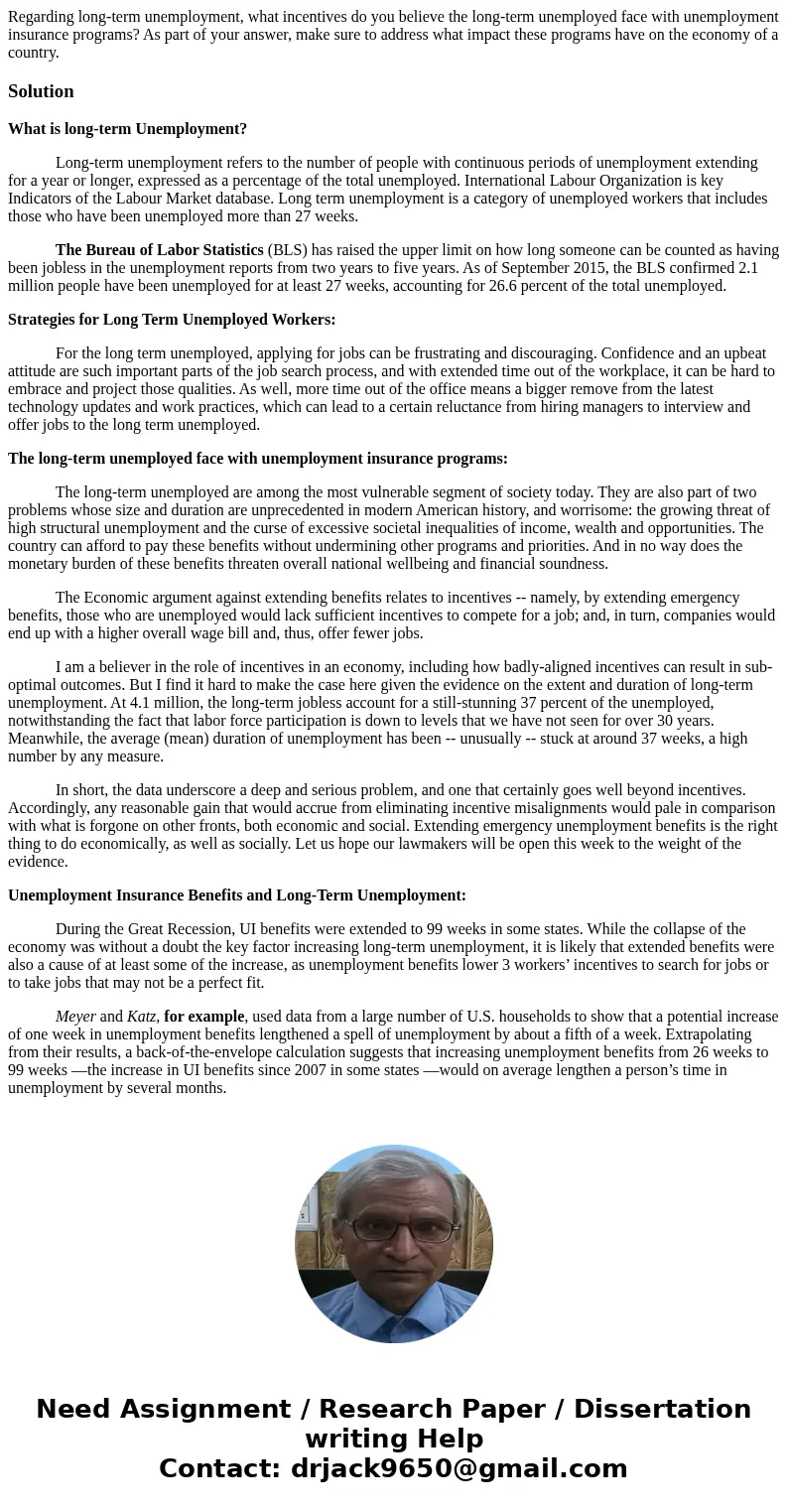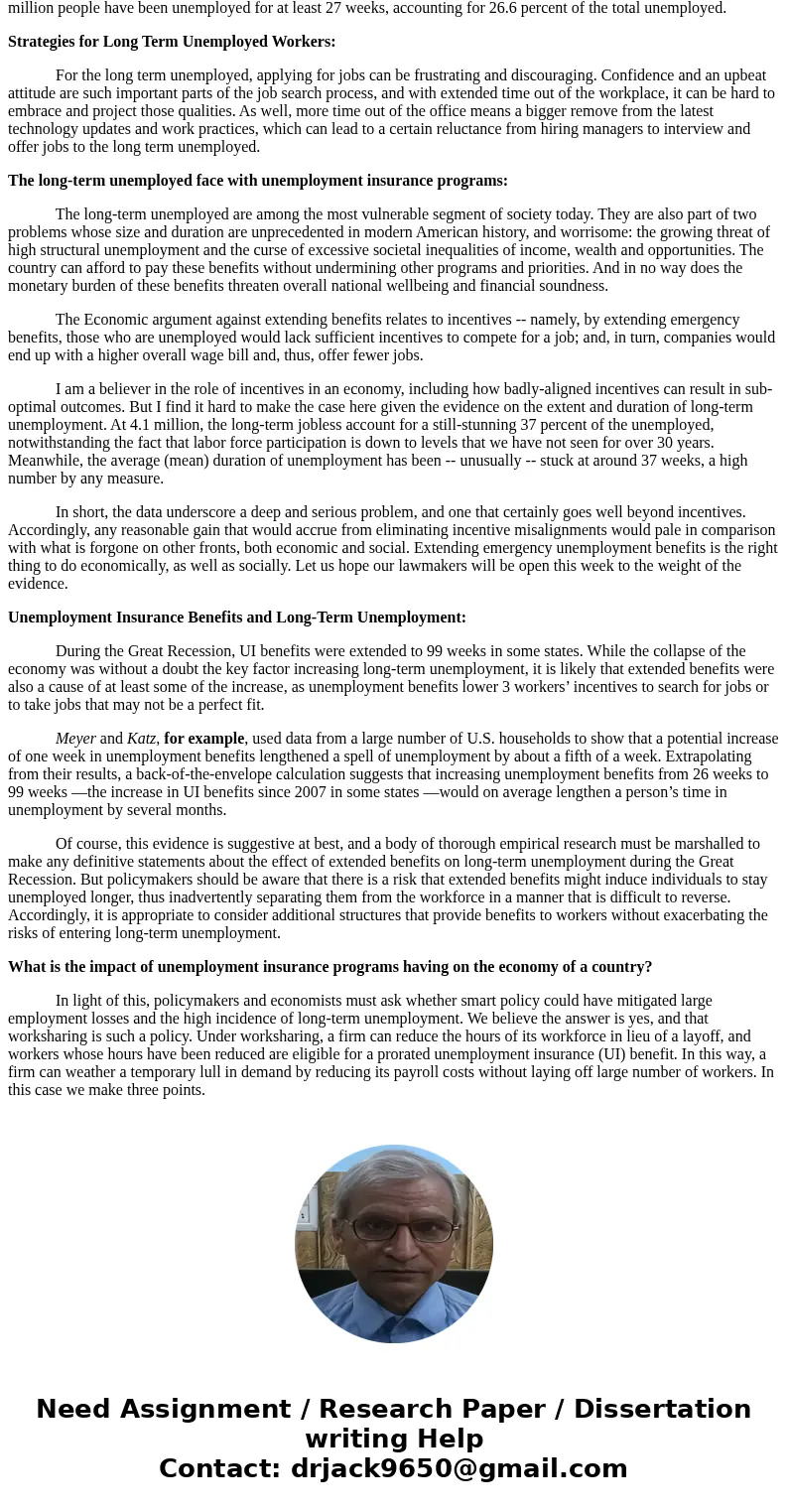Regarding longterm unemployment what incentives do you belie
Regarding long-term unemployment, what incentives do you believe the long-term unemployed face with unemployment insurance programs? As part of your answer, make sure to address what impact these programs have on the economy of a country.
Solution
What is long-term Unemployment?
Long-term unemployment refers to the number of people with continuous periods of unemployment extending for a year or longer, expressed as a percentage of the total unemployed. International Labour Organization is key Indicators of the Labour Market database. Long term unemployment is a category of unemployed workers that includes those who have been unemployed more than 27 weeks.
The Bureau of Labor Statistics (BLS) has raised the upper limit on how long someone can be counted as having been jobless in the unemployment reports from two years to five years. As of September 2015, the BLS confirmed 2.1 million people have been unemployed for at least 27 weeks, accounting for 26.6 percent of the total unemployed.
Strategies for Long Term Unemployed Workers:
For the long term unemployed, applying for jobs can be frustrating and discouraging. Confidence and an upbeat attitude are such important parts of the job search process, and with extended time out of the workplace, it can be hard to embrace and project those qualities. As well, more time out of the office means a bigger remove from the latest technology updates and work practices, which can lead to a certain reluctance from hiring managers to interview and offer jobs to the long term unemployed.
The long-term unemployed face with unemployment insurance programs:
The long-term unemployed are among the most vulnerable segment of society today. They are also part of two problems whose size and duration are unprecedented in modern American history, and worrisome: the growing threat of high structural unemployment and the curse of excessive societal inequalities of income, wealth and opportunities. The country can afford to pay these benefits without undermining other programs and priorities. And in no way does the monetary burden of these benefits threaten overall national wellbeing and financial soundness.
The Economic argument against extending benefits relates to incentives -- namely, by extending emergency benefits, those who are unemployed would lack sufficient incentives to compete for a job; and, in turn, companies would end up with a higher overall wage bill and, thus, offer fewer jobs.
I am a believer in the role of incentives in an economy, including how badly-aligned incentives can result in sub-optimal outcomes. But I find it hard to make the case here given the evidence on the extent and duration of long-term unemployment. At 4.1 million, the long-term jobless account for a still-stunning 37 percent of the unemployed, notwithstanding the fact that labor force participation is down to levels that we have not seen for over 30 years. Meanwhile, the average (mean) duration of unemployment has been -- unusually -- stuck at around 37 weeks, a high number by any measure.
In short, the data underscore a deep and serious problem, and one that certainly goes well beyond incentives. Accordingly, any reasonable gain that would accrue from eliminating incentive misalignments would pale in comparison with what is forgone on other fronts, both economic and social. Extending emergency unemployment benefits is the right thing to do economically, as well as socially. Let us hope our lawmakers will be open this week to the weight of the evidence.
Unemployment Insurance Benefits and Long-Term Unemployment:
During the Great Recession, UI benefits were extended to 99 weeks in some states. While the collapse of the economy was without a doubt the key factor increasing long-term unemployment, it is likely that extended benefits were also a cause of at least some of the increase, as unemployment benefits lower 3 workers’ incentives to search for jobs or to take jobs that may not be a perfect fit.
Meyer and Katz, for example, used data from a large number of U.S. households to show that a potential increase of one week in unemployment benefits lengthened a spell of unemployment by about a fifth of a week. Extrapolating from their results, a back-of-the-envelope calculation suggests that increasing unemployment benefits from 26 weeks to 99 weeks —the increase in UI benefits since 2007 in some states —would on average lengthen a person’s time in unemployment by several months.
Of course, this evidence is suggestive at best, and a body of thorough empirical research must be marshalled to make any definitive statements about the effect of extended benefits on long-term unemployment during the Great Recession. But policymakers should be aware that there is a risk that extended benefits might induce individuals to stay unemployed longer, thus inadvertently separating them from the workforce in a manner that is difficult to reverse. Accordingly, it is appropriate to consider additional structures that provide benefits to workers without exacerbating the risks of entering long-term unemployment.
What is the impact of unemployment insurance programs having on the economy of a country?
In light of this, policymakers and economists must ask whether smart policy could have mitigated large employment losses and the high incidence of long-term unemployment. We believe the answer is yes, and that worksharing is such a policy. Under worksharing, a firm can reduce the hours of its workforce in lieu of a layoff, and workers whose hours have been reduced are eligible for a prorated unemployment insurance (UI) benefit. In this way, a firm can weather a temporary lull in demand by reducing its payroll costs without laying off large number of workers. In this case we make three points.


 Homework Sourse
Homework Sourse